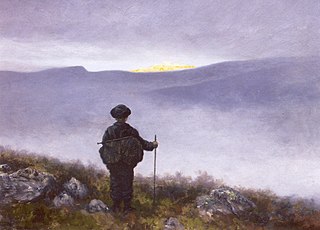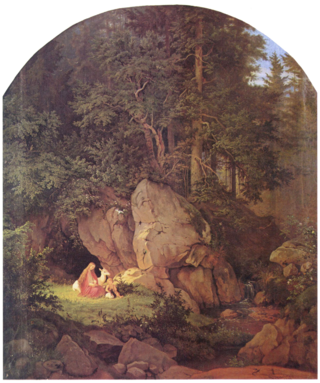
A quest is a journey toward a specific mission or a goal. It serves as a plot device in mythology and fiction: a difficult journey towards a goal, often symbolic or allegorical. Tales of quests figure prominently in the folklore of every nation and ethnic culture. In literature, the object of a quest requires great exertion on the part of the hero, who must overcome many obstacles, typically including much travel. The aspect of travel allows the storyteller to showcase exotic locations and cultures. The object of a quest may also have supernatural properties, often leading the protagonist into other worlds and dimensions. The moral of a quest tale often centers on the changed character of the hero.

"Beauty and the Beast" is a fairy-tale written by French novelist Gabrielle-Suzanne Barbot de Villeneuve and published in 1740 in La Jeune Américaine et les contes marins.

In mythology, folklore and speculative fiction, shapeshifting is the ability to physically transform oneself through unnatural means. The idea of shapeshifting is found in the oldest forms of totemism and shamanism, as well as the oldest existent literature and epic poems such as the Epic of Gilgamesh and the Iliad. The concept remains a common literary device in modern fantasy, children's literature and popular culture. Examples of shapeshifters are vampires and werewolves.

Princess and dragon is an archetypical premise common to many legends, fairy tales, and chivalric romances. Northrop Frye identified it as a central form of the quest romance.

The Frog Princess is a fairy tale that has multiple versions with various origins. It is classified as type 402, the animal bride, in the Aarne–Thompson index. Another tale of this type is the Norwegian Doll i' the Grass. Eastern European variants include the Frog Princess or Tsarevna Frog and also Vasilisa the Wise ; Alexander Afanasyev collected variants in his Narodnye russkie skazki, a collection which included folk tales from Ukraine and Belarus alongside Russian tales.

"The Twelve Dancing Princesses" is a German fairy tale collected by the Brothers Grimm and published in Grimm's Fairy Tales in 1815. It is of Aarne-Thompson type 306.

"The Golden Bird" is a fairy tale collected by the Brothers Grimm about the pursuit of a golden bird by a gardener's three sons.

"The Juniper Tree" is a German fairy tale published in Low German by the Brothers Grimm in Grimm's Fairy Tales in 1812. The story contains themes of child abuse, murder, cannibalism and biblical symbolism and is one of the Brothers Grimm's darker and more mature fairy tales.

"Kate Crackernuts" is a Scottish fairy tale collected by Andrew Lang in the Orkney Islands and published in Longman's Magazine in 1889. Joseph Jacobs edited and republished the tale in his English Fairy Tales (1890). The tale is about a princess who rescues her beautiful sister from an evil enchantment and a prince from a wasting sickness caused by dancing nightly with the fairies. The tale has been adapted to a children's novel and a stage play.

"The Singing, Springing Lark", "The Singing, Soaring Lark", "The Lady and the Lion" or "Lily and the Lion" is a German fairy tale collected by the Brothers Grimm, appearing as tale no. 88.
The Giant Who Had No Heart in His Body is a Norwegian fairy tale collected by Asbjørnsen and Moe.
The Red Ettin or The Red Etin is a fairy tale collected by Joseph Jacobs. It was included by Andrew Lang in The Blue Fairy Book.

The Dancing Water, the Singing Apple, and the Speaking Bird is a Sicilian fairy tale collected by Giuseppe Pitrè, and translated by Thomas Frederick Crane for his Italian Popular Tales. Joseph Jacobs included a reconstruction of the story in his European Folk and Fairy Tales. The original title is "Li Figghi di lu Cavuliciddaru", for which Crane gives a literal translation of "The Herb-gatherer's Daughters."

The false hero is a stock character in fairy tales, and sometimes also in ballads. The character appears near the end of a story in order to claim to be the hero or heroine and is usually of the same sex as the hero or heroine. The false hero presents some claim to the position. By testing, it is revealed that the claims are false, and the hero's true. The false hero is usually punished, and the true hero takes their place.
Molly Whuppie is an English language fairy tale set in Scotland. It was first published in 'Three Folk-Tales from Old Meldrum, Aberdeenshire' in "Folklore" (6.2.1884). Rev. Walter Gregor said that the tales had been 'communicated to me by Mr. Moir, Rector of the Grammar School, Aberdeen. He had them from his mother, who kindly wrote out " Mally Whuppie " and " The Red Calf" at my request.' Anglicising the name to "Molly" from "Mally" Joseph Jacobs used this source of the story in his English Fairy Tales. A Highland version, Maol a Chliobain, was collected by John Francis Campbell in Popular Tales of the West Highlands. Jacobs noted the relationship between the two tales, and an Irish variant, "Smallhead," and concluded that the tale was Celtic in origin.
"The King of Lochlin's Three Daughters" is a Scottish fairy tale collected by John Francis Campbell in his Popular Tales of the West Highlands, listing his informant as Neill Gillies, a fisherman near Inverary.

In folklore and fantasy, an enchanted forest is a forest under, or containing, enchantments. Such forests are described in the oldest folklore from regions where forests are common, and occur throughout the centuries to modern works of fantasy. They represent places unknown to the characters, and situations of liminality and transformation. The forest can feature as a place of threatening danger, or one of refuge, or a chance at adventure.

The Greek Princess and the Young Gardener is an Irish fairy tale collected by Patrick Kennedy in Fireside Stories of Ireland. Joseph Jacobs included it in More Celtic Fairy Tales.

In fairy tales, a donor is a character who tests the hero and provides magical assistance to the hero upon their success.
The Hedgehog, the Merchant, the King and the Poor Man is a Hungarian fairy tale collected by László Merényi and translated by folklorist Jeremiah Curtin.

















